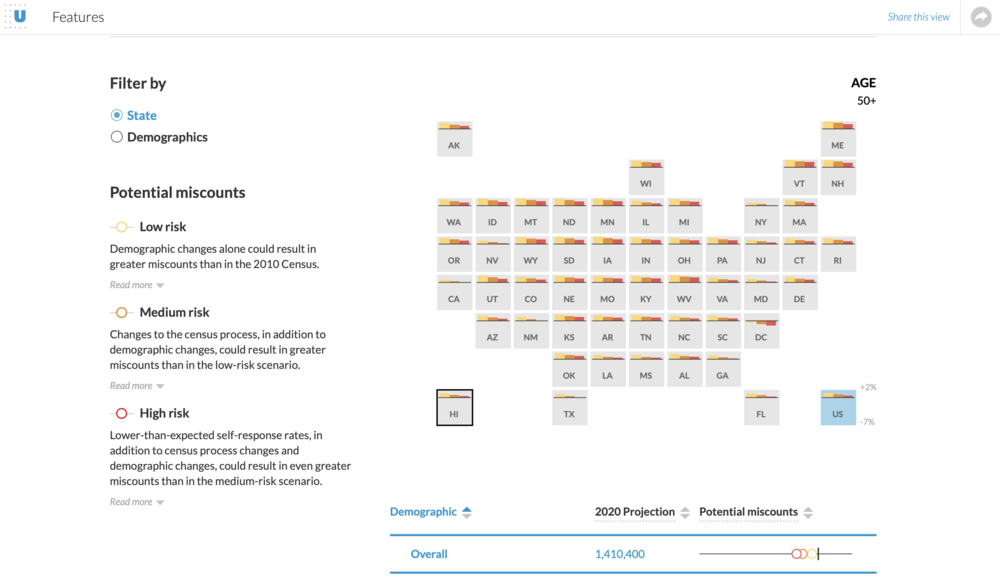The 2020 Census – It’s Hard to Overstate How Important This Is for Hawaii
by Nick Redding, Hawaii Data Collaborative
Census Day is April 1st. What does that mean? It means by that date every household in Hawaii, and across the US, will have received an invitation to complete the 2020 decennial Census online, by mail, or by phone.
Why does the Census Count matter?
Why should we care about a complete Census count? Here are three primary reasons:
Lines on the map: Census data is used to determine the number of seats each State has in the U.S. House of Representatives. It is also used by states to draw congressional district boundaries.
Federal money to states: Census population numbers determine how many federal dollars are distributed across states for infrastructure, housing, education, health and other programs. A study by George Washington University’s Institute of Public Policy estimates that for funding year 2015, Hawaii missed out on $1,189 of federal funds per resident, totaling almost $16.2M less funding for the state.
Data… and more data: The U.S. Census provides some of our most important data for understanding our communities, and is relied upon broadly for making critical decisions regarding public-sector, non-profit, and for-profit investment priorities.
Despite its importance, people have mixed levels of commitment to participating in the Census count. A recent U.S. poll conducted by the Census found that 58 percent of the general population will “Definitely” participate in the Census, with an additional 25 percent indicating they would “Probably” participate. Willingness to participate is lower for younger participants, and those identifying as Asian American, African American, or Muslim.
Who Tends to Be Undercounted in Hawaii, and Where Do They Live?
In 2000, 2.2 percent of Hawaii residents were undercounted. While 2.2 percent may not seem like much, based on 2018 estimates, that same result today would be over 31,000 residents. Furthermore, estimates suggest an undercount of 1.3 percent of Native Hawaiians and Pacific Islanders in 2010.
To help understand areas in Hawaii vulnerable to undercount, we can use the Response Outreach Area Mapper (ROAM) tool, a Census tool that highlights likely non-response rates by tract. The darker blue regions are those that are likely to have a non-response rate of 30.0 to 48.4 percent:
Another useful tool, developed by the Urban Institute, allows interested users to explore how miscounts are projected to differ both by state and demographic, with the possibility to filter by state to highlight potential demographic miscounts in that state:
You can check out the miscount projection tool here. Select Hawaii, and you will see that Black and Hispanic/Latino residents are the most likely to be uncounted, as are children younger than five. This last group is projected to be undercounted by as much as 6.3%.
Accurate Census Counts Drive Solid Data
While we of course value representation and the flow of federal dollars to local programs, it is the third reason for caring about the Census that is nearest and dearest to our mission at the Hawaii Data Collaborative. The visualization tools we are able to offer the community rely heavily on Census data. For example, of the 102 indicators that we include in our regional tools, 53 come directly from the Census. The remaining indicators may not come directly from the Census, but they are invariably shaped by Census population estimates, demographic breakdowns, and other foundational data used to situate any robust data collection effort. Further, the deeper dive analyses that we are now engaging in are by nature multidimensional – for each of those, Census data serves as the solid foundation from which a collaborative, data-driven effort is supported.
Want to Learn More About Census Efforts in Hawaii?
There are multiple efforts underway in Hawaii to encourage a complete Census count. A list of local Complete Count committees can be found here. Other helpful resources include the 2020 Hawaii Government Complete Count Committee, and the Hawaii State Department of Business, Economic Development & Tourism: FAQs on Census 2020.
Additionally, here are some recent media articles focused on the Hawaii 2020 count:
Note: An earlier version of this post incorrectly reported that 0.4 percent of Hawaii residents were undercounted in 2010, when 0.4 percent of Hawaii residents were actually overcounted in 2010.


